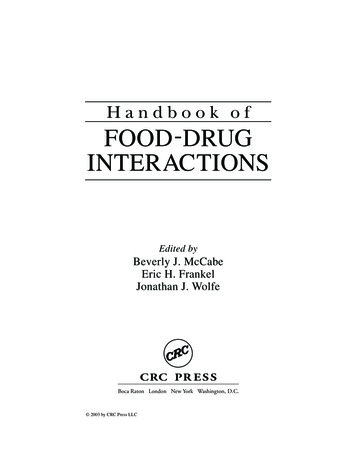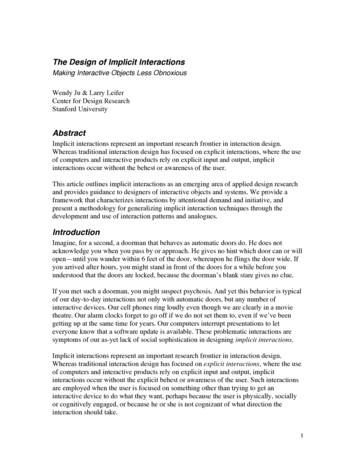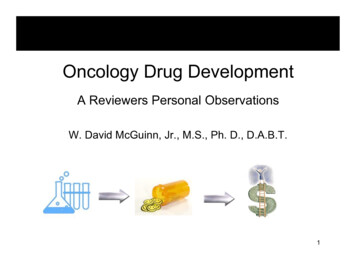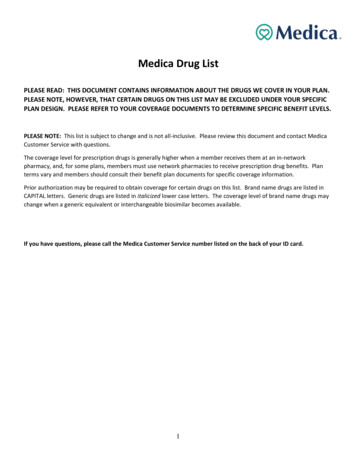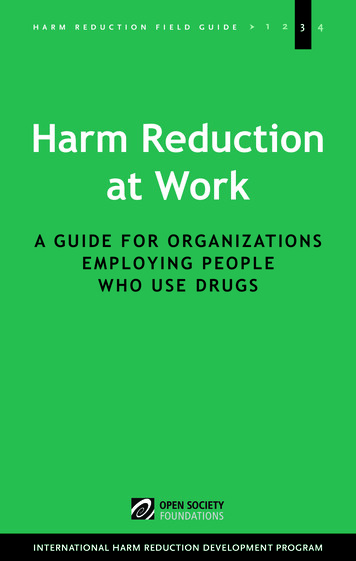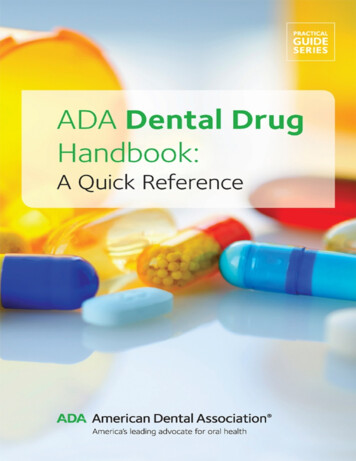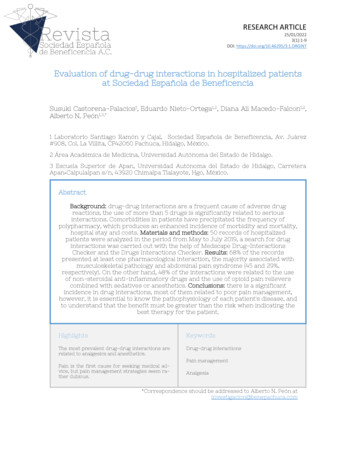
Transcription
RESEARCH ARTICLE25/01/20223(1):1-9DOI: https://doi.org/10.46295/3:1.DRGINTEvaluation of drug-drug interactions in hospitalized patientsat Sociedad Española de BeneficenciaSusuki Castorena-Palacios1, Eduardo Nieto-Ortega1,2, Diana Ali Macedo-Falcon1,2,Alberto N. Peón1,3,*1 Laboratorio Santiago Ramón y Cajal, Sociedad Española de Beneficencia, Av. Juárez#908, Col. La Villita, CP42060 Pachuca, Hidalgo, México.2 Área Académica de Medicina, Universidad Autónoma del Estado de Hidalgo.3 Escuela Superior de Apan, Universidad Autónoma del Estado de Hidalgo, CarreteraApan‑Calpulalpan s/n, 43920 Chimalpa Tlalayote, Hgo, México.AbstractBackground: drug-drug interactions are a frequent cause of adverse drugreactions, the use of more than 5 drugs is significantly related to seriousinteractions. Comorbidities in patients have precipitated the frequency ofpolypharmacy, which produces an enhanced incidence of morbidity and mortality,hospital stay and costs. Materials and methods: 50 records of hospitalizedpatients were analyzed in the period from May to July 2019, a search for druginteractions was carried out with the help of Medscape Drug-InteractionsChecker and the Drugs Interactions Checker. Results: 68% of the recordspresented at least one pharmacological interaction, the majority associated withmusculoskeletal pathology and abdominal pain syndrome (45 and 29%,respectively). On the other hand, 48% of the interactions were related to the useof non-steroidal anti-inflammatory drugs and the use of opioid pain relieverscombined with sedatives or anesthetics. Conclusions: there is a significantincidence in drug interactions, most of them related to poor pain management,however, it is essential to know the pathophysiology of each patient's disease, andto understand that the benefit must be greater than the risk when indicating thebest therapy for the patient.HighlightsKeywordsThe most prevalent drug-drug interactions arerelated to analgesics and anesthetics.Drug-drug interactionsPain is the first cause for seeking medical advice, but pain management strategies seem rather dubious.Pain managementAnalgesia*Correspondence should be addressed to Alberto N. Peón atinvestigacion@benepachuca.com
INTRODUCTIONDrug-drug interactions are a common cause of adverse drug reactions, and aremore serious in elderly patients, patients with multiple comorbidities, and patients subjected to polypharmacy. Multiple pathologies, such as diabetes, systemic arterial hypertension, obesity, heart disease, etc. have forced the use ofmultiple drugs for their treatment, increasing the possibility of drug-drug interactions (1).Pharmacological interactions arise when a drug interacts with another, modifying its pharmacokinetics or pharmacodynamics, thus, a negative or positive effect may occur with the interaction of the drugs (2). Drug interactions can beclassified depending on the mechanism of action of the interaction or based onits severity. Pharmacokinetic interactions occur when the ADME (absorption, distribution, enzymatic metabolism, and excretion) of one drug is affected by another drug. Pharmacodynamics are affected when drugs interact on the samereceptor or physiological system, resulting in additive interactions or in antagonistic interactions when drugs have opposing effects (3).The risk classification of drug-drug interactions is established as A, B, C, D and X.Risk category "A" without any evidence of drug interaction, category "B" with evidence of interaction, but without clinical relevance, in "A" and "B", no action isrequired, therefore the use of drugs is safe; for category “C”, therapy monitoringis required, as there is clinically significant drug interaction but with greater benefit than risk. For category “D”, there must be a modification of the therapy, whichmay imply dose adjustment, an alternative therapy and intensive control to minimize toxicity. In risk category "X", drug combinations should be avoided sincethere is a greater risk tha benefit, thus drug combinations are contraindicated(4).It has been observed that DDI could bring adverse drug reactions, increase morbidity and mortality, longer hospital stays and enhanced hospital costs. In a multicenter retrospective observational study, it was identified that up to 30% of patients in the intensive care units are exposed to DDi's, most frequently observedin drugs that increase the QT interval, digoxin and NSAIDs (non-steroidal antiinflammatory drugs) (5).In another study carried out in elderly patients, a total of 216 serious or very serious interactions were identified, 48.9% of the patients had the risk of at leastone serious interaction, patients with more than 4 drugs had a risk for presentinginteractions of 84% (AUC 0.781, p 0.0001) (6). In México, the Comision Nacionalde Arbitraje Médico (CONAMED) conducted a study of patients with diverse medical complaints finding that 48.5% of them presented moderate interactions and43% were found to be subjected to serious interactions. 63.9% of them consumedmore than 5 medications. Bezafibrate, pravastatin, captopril, metformin, acetylsalicylic acid, diclofenac, insulin and Enalapril were the drugs most involved (2).In such context, a search for drug-drug interactions was carried out in patientsof the Sociedad Española de Beneficencia hospital in Pachuca, Hidalgo, based on2
clinical records in order to determine the incidence of such problem, and to identify the most common flawed prescriptions.Materials and methodsA total of 50 clinical files belonging to patients attended at the Sociedad Españolade Beneficencia, Pachuca, Hidalgo Hospital were analyzed, disregarding the diagnosis. All the clinical files were gathered between May and July of 2019, with theinclusion criteria of i) patients of both genders, ii) with ages between 14 and 60years. Clinical files of i) pregnant women and ii) patients with hepatic and renaldamage were excluded.The clinical files were checked for drug-drug interactions in concomitantly administered medication by using the Medscape Drug Interactions Checker(7) andthe Drugs Interactions Checker(8) and all interactions were plotted into Exceldocuments to quantify any typify their occurrence.Results and discussionOf the 50 clinical files that were analyzed we found 33 (68%) records with at leastone drug-drug interaction and 16 (32%) that did not present any interactions (Fig.1a). The diagnoses ranged within muscle-skeletal trauma (45%), acute abdomentype pathologies (29%), gineco-obstetric phenomena (8%), surgery-related phenomena (6%), infectious diseases (4%) and other scattered phenomena (8%) (Fig.1b). Most (48%) of these interactions were related to non-steroideal anti-inflammatory drugs (NSAIDs), followed by analgesic/anesthetic drugs (AA) (29%), andsteroids (16%) (Fig. 1c). In fact, the five most commonly misprescribed drugs werefound to be ketorolac (found in 39% of the files), followed by parecoxib (25%), dexamethasone (14%), enoxaparin (11%) and diclofenac (11%) (Fig. 1d).3
Figure 1. Description of the drug-drug interactions. The total number ofclinical files that presented at least one drug-drug interaction wasquantified (a), while the diagnostics for their prescriptions was also pondered (b). Moreover, the types of drugs involved in the detected interactions were also described (c) while pinpointing the specific drugs ineach substance type that are most commonly misprescribed (d).We further characterized the specific incidence of drug-drug interactions,finding that the parecoxib-ketorolac interaction was the most common,occurring 25 times (48% of NSAID DDIs) (Fig. 2a, Table 1), followed by diclofenacketorolac, which occurred 10 times (19% of NSAID DDIs) (Fig. 2a, Table 1), thenfentanyl-propofol, which occurred 9 times (29% of AA DDIs) (Fig. 2b, Table 2),ketorolac-enoxaparin (7 times, 13% of NSAID DDIs) (Fig. 2a, Table 1),dexamethasone-fentanyl and parecoxib-dexametasone, which occurred 6 times(35% of steroid DDIs) (Fig. 2c, Table 3). Although present in the study, other DDIswere not highly incident (Fig. 2d, Table 4), thus we observe a pattern ofenhanced DDIs in the setting of pain management, as NSAIDs, AA andcorticosteroids were the drug types that were most commonly misprescribed.It has been estimated that 42% of people experience pain before seeking medicaladvice (9), while this condition has been linked to at least 40% of the reasons fora patient to seek medical advice outside of the emergency department (10) and4
to 70.7% of the reasons for patients to visit an emergency department (11).Moreover, the prevalence of chronic pain has been estimated between 11% and40% of the population (12), and post-operative pain has been detected in 37.5% ofpatients (13), of whom 12% described a severe to extreme pain and 54% amoderate pain (14).Figure 2. Most common DDIs for each drug type. The specific DDi in thecategories of NSAIDs (a), analgesics/anesthetics (b), steroids (c), or varieddrugs (d) were quantified and expressed as percentages among thecategories.5
On the other hand, our results show (Fig. 1b) that most of the prescriptions wererelated to muscle-skeletal trauma and acute abdomen-type pathologies, whichtend to cause severe pain, and in some instances require surgery. As such itwas expected to find an intense use of NSAIDs, analgesics/anesthetics andstrong anti-inflammatory drugs that can also counteract pain, likecorticosteroids.DDIs are mostly predictable, and tend to occur as a sub-product ofpolypharmacy (15), but can also originate from the lack of knowledge about thepharmacokinetic and pharmacodynamics properties of each drug, as well astheir metabolism (16). Moreover, we detected an ample incidence of DDIs related6
to the prescription of two NSAIDs combined, two steroids, or two AAs, whichreflects a strong intent to manage pain, but on a less efficient manner.Nalamachu (16) suggests that “Appropriate treatment of pain requires anunderstanding of the characteristics of pain, including the severity and thenature of the pain-for example, acute versus chronic pain or nociceptive versusneuropathic pain. Appropriate treatment requires an understanding of theefficacies of the available agents in different pain models, and their adverseevents, to best match them to the type of pain.”, in regards to an efficienttreatment of pain. We thus think that more knowledge about thepathophysiology of inflammation and pain, as well as the metabolic,pharmacodynamics and pharmacokinetic properties of steroids, NSAIDs andAAs may be able to transform this panorama.One of the limitations of the study is that patients are not discriminated basedon their diagnoses of hospital stay, relevant for the fact that multiplepathologies require the combination of drugs that in theory could presentimportant pharmacological interactions, However, the benefit outweighs therisk, for example, patients with an acute coronary syndrome, who require adouble anti-aggregation with aspirin and clopidogrel also combined with ananticoagulant such as enoxaparin or the new ones administered orally such asrivaroxaban (17). On the other hand, the combination of opioid analgesicstogether with sedatives such as Propofol, is necessary for the management ofcritical patients who are in intensive therapy under mechanical ventilation andwho need to be under sedation and analgesia part of the time of theirtherapeutic stay (18).ConclusionsWe found that more than a half of the clinical files that were included in ourstudy presented at least one DDI. The most commonly misprescribed drugswere NSAIDs, followed by analgesics/anesthetics, and finally steroids, all ofwhich relate with the management of pain. We think that these results were tobe expected as pain is a very common condition, especially among people thatseek medical attention. Nonetheless, the fact that the most prescribed drugs forthis situation are commonly misprescribed suggests that both thepathophysiology of pain and the properties of analgesics may not be soundlyunderstood. We think that more awareness and knowledge may be key factorsto put a halt to this phenomenon.AcknowledgementsAll the authors wish to thank Sociedad Española de Beneficencia for providingthe technical and finantial means for the publication of the present study.Eduardo Nieto-Ortega and Alí Macedo-Falcon receive a full scolarship fromsuch institution, for which they are also thankful.References1.Lopez-Picazo JJ, Ruiz JC, Sanchez JF, Ariza A, Aguilera B, Lazaro D, et al.Prevalence and typology of potential drug interactions occurring in primarycare patients. Eur J Gen Pract. 2010 Jun;16(2):92–9.7
2.Hernández JLG. Interacciones farmacológicas potenciales en pacientesambulatorios en expedientes de queja médica de la CONAMED. Rev CONAMED.2020;25(3):115–22.3.Brewer L, Williams D. Clinically relevant drug-drug and drug-foodinteractions. Pharmaceut Med. 2013;27(1):9–23.4.Shetty V, Chowta MN, Chowta K N, Shenoy A, Kamath A, Kamath P.Evaluation of potential drug-drug interactions with medications prescribed togeriatric patients in a tertiary care hospital. J Aging Res. 2018;2018.5.Bakker T, Abu-Hanna A, Dongelmans DA, Vermeijden WJ, Bosman RJ, deLange DW, et al. Clinically relevant potential drug-drug interactions in intensivecare patients: A large retrospective observational multicenter study. J Crit Care.2021;62:124–30.6.Petrini E, Caviglia GP, Pellicano R, Saracco GM, Morino M, Ribaldone DG.Risk of drug interactions and prescription appropriateness in elderly patients.Irish J Med Sci. 2020;189(3):953–9.7.Medscape. Medscape Drug Interaction Checker [Internet]. 2020. Availablefrom: cker8.Drugs. Drug Interactions Checker - For Drugs, food and alcohol [Internet].2021 [cited 2021 Dec 31]. Available from:https://www.drugs.com/drug interactions.html9.Galinski M, Ruscev M, Gonzalez G, Kavas J, Ameur L, Biens D, et al.Prevalence and management of acute pain in prehospital emergency medicine.Prehospital Emerg care Off J Natl Assoc EMS Physicians Natl Assoc State EMSDir. 2010;14(3):334–9.10.Mäntyselkä P, Kumpusalo E, Ahonen R, Kumpusalo A, Kauhanen J,Viinamäki H, et al. Pain as a reason to visit the doctor: a study in Finnishprimary health care. Pain. 2001 Jan;89(2–3):175–80.11.Mura P, Serra E, Marinangeli F, Patti S, Musu M, Piras I, et al. Prospectivestudy on prevalence, intensity, type, and therapy of acute pain in a secondlevel urban emergency department. J Pain Res. 2017;10:2781–8.12.Kuehn B. Chronic Pain Prevalence. JAMA. 2018 Oct;320(16):1632.13.Domínguez HJG, Sandoval LCG DC. Postoperative pain prevalence. ActaMed. 2016;14((2)):84–9.14.Buvanendran A, Fiala J, Patel KA, Golden AD, Moric M, Kroin JS. TheIncidence and Severity of Postoperative Pain following Inpatient Surgery. PainMed. 2015 Dec;16(12):2277–83.15.Carpenter M, Berry H, Pelletier AL. Clinically Relevant Drug-DrugInteractions in Primary Care. Am Fam Physician. 2019 May;99(9):558–64.16.Astrand B. Avoiding drug-drug interactions. Chemotherapy.2009;55(4):215–20.17.Ibáñez B, James S, Agewall S, Antunes MJ, Bucciarelli-Ducci C, Bueno H, etal. Guía ESC 2017 sobre el tratamiento del infarto agudo de miocardio enpacientes con elevación del segmento ST. Rev española Cardiol. 2017;70(12):1082e1.18.Celis-Rodríguez E, Díaz Cortés JC, Cárdenas Bolívar YR, CarrizosaGonzález JA, Pinilla D-I, Ferrer Záccaro LE, et al. Evidence-based clinical practiceguidelines for the management of sedoanalgesia and delirium in critically illadult patients. Med intensiva. 2020 Apr;44(3):171–84.8
de Beneficencia, Pachuca, Hidalgo Hospital were analyzed, disregarding the diag-nosis. All the clinical files were gathered between May and July of 2019, with the inclusion criteria of i) patients of both genders, ii) with ages between 14 and 60 years. Clinical files of i) pregnant women and ii) patients with hepatic and renal damage were excluded.

